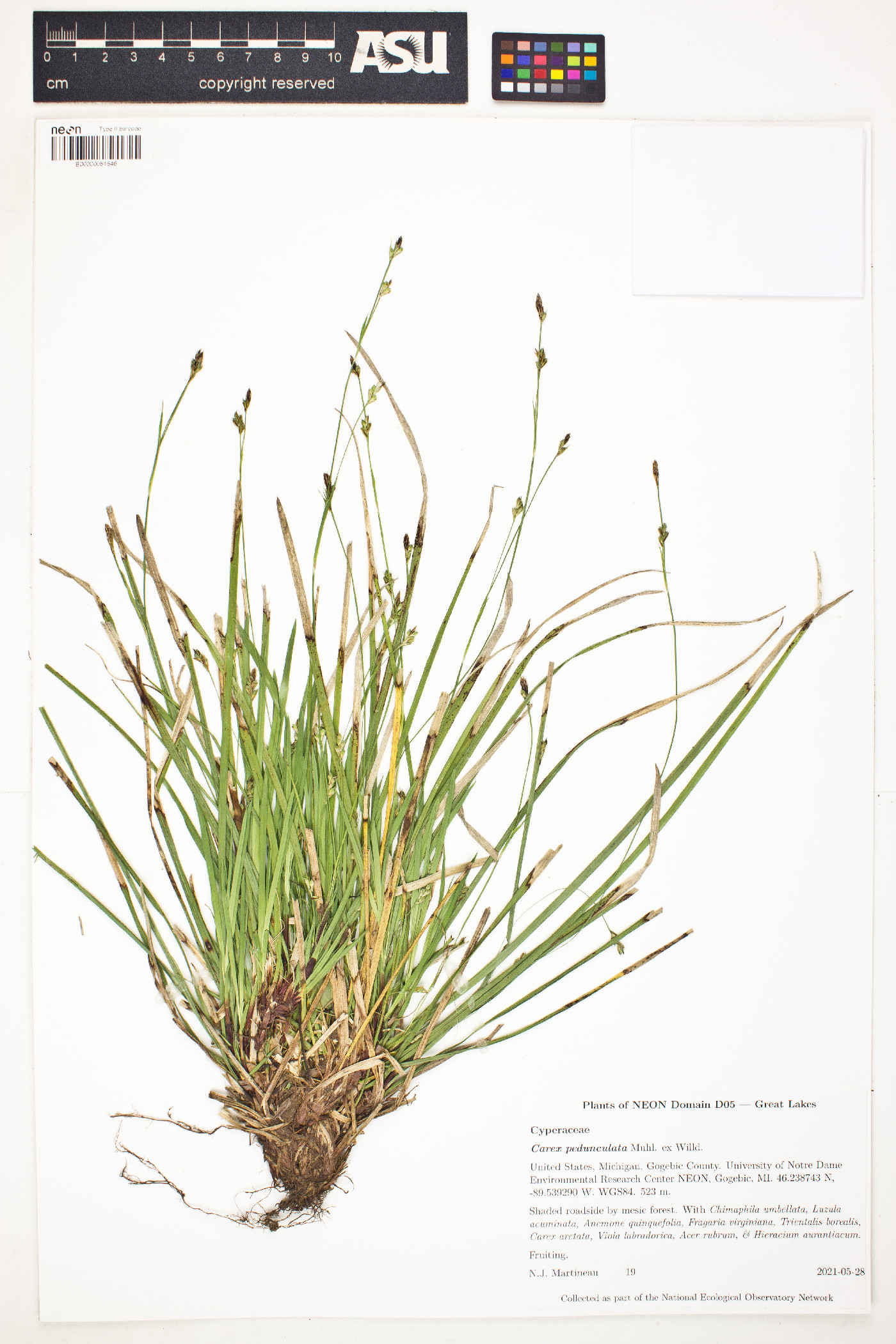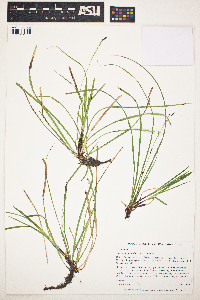|
|
|
|
Family: Cyperaceae
longstalk sedge
|
Plants cespitose, stout-rhizomatous. Culms 8.8-28 cm. Leaves: basal sheaths dark reddish to purplish brown; blades mostly basal, dark green, equaling or mostly exceeding culms, 1.4-4 mm wide, thick, margins smooth or scabrous. Inflorescences: peduncles of basal pistillate spikes filiform, arching, to 13 cm; peduncles of terminal staminate spikes 2-6 cm; proximal bracts short-sheathing; pistillate spikes 2-5, mostly emerging from basal nodes, proximal spikes arching, distal ones ascending, short-pedunclulate, widely separated, often with 1-2 staminate flowers at apex, obovoid to ellipsoid; terminal staminate spikes usually with 2-5 pistillate flowers at base, 7.5-9.8 × 1.8-2.3 mm. Scales: pistillate scales pale brown to reddish brown, ovate to obovate, apex retuse or truncate to obtuse, cuspidate; staminate scales dark reddish brown, ovate, apex cuspidate. Anthers 2-3.6 mm. Perigynia obovoid to oblanceoloid, 3.7-6 × 1.4-1.7 mm, base tapering, pubescent with short straight hairs; beak bent, 0.2-0.4 mm. Stigmas 3, thin, flexuous, strongly papillose. Achenes ellipsoid, 2.5 × 1.5-1.6 mm. 2n = 26. Fruiting spring-summer (mid Apr-early Jul). Moist to dry mixed forests and woodland openings, on basic and acidic substrates; 0-800 m; St. Pierre and Miquelon; Alta., B.C., Man., N.B., Nfld. and Labr., N.S., Ont., Que., Sask.; Ala., Conn., Del., Ga., Ill., Ind., Iowa, Ky., Maine, Md., Mass., Mich., Minn., N.H., N.J., N.Y., N.C., Ohio, Pa., R.I., S.Dak., Tenn., Vt., Va., W.Va., Wis.; e Asia. Carex pedunculata exhibits the classical eastern North American eastern Asian disjunct distribution pattern (P. W. Ball 1990). The Korean counterpart is known as var. erythrobasis (H. Léveillé & Vaniot) T. Koyama.
Tufted and often shortly rhizomatous; most lvs basal, thickish and stiff, 1-3 dm נ2-3 mm; fertile stems 1-3 dm, with 4-5 spikes 6-15 mm; uppermost spike staminate or commonly with a few basal perigynia; anthers 2-3 mm; pistillate spikes often with a few terminal staminate fls, the upper 1 or 2 not far from the summit, the lower 1 or 2 on long slender peduncles from near the base, often concealed by the lvs; pistillate scales obovate-oblong, the body broadly obtuse to truncate, extending to or beyond the broadest part of the perigynium, the thin sides purple-brown with hyaline margins, the green center prolonged into a cusp equaling or surpassing the perigynium; perigynia with a basal elaiosome, ant- dispersed, obovoid, 3.5-5 mm, roundly angled on the back, keeled on the lateral angles, thinly hairy to glabrate, minutely beaked; achene sharply trigonous; 2n=26. Rich woods, usually in calcareous soil; Nf. to Sask. and S.D., s. to N.C., Ala., and Io., abundant in the Great Lakes region. Fl early, fr May. Gleason, Henry A. & Cronquist, Arthur J. 1991. Manual of vascular plants of northeastern United States and adjacent Canada. lxxv + 910 pp. ©The New York Botanical Garden. All rights reserved. Used by permission. |




